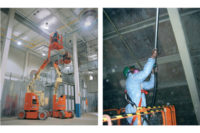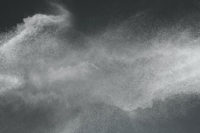“ An emergency exists concerning worker exposure to combustible dust explosions and fires, and there is a significant risk of death or severe injury to workers employed at facilities where combustible dusts are present. ”
[Bill HR 691 Section 2 (1)]
This is a direct quote from HR691: “Worker Protection Against Combustible Dust Explosions and Fires Act of 2013,” a bill introduced in Congress in February 2013. The goal of the bill: require the Secretary of Labor to issue an interim set of standards regulating the control of combustible dust and to finalize a permanent ruling within three years of the interim standard. What events led to this legislative push?
A brief review of regulations
Combustible dust risks are not new. In 2003, there were three catastrophic dust explosions that killed 14 workers. Subsequently, the Chemical Safety and Hazard Investigation Board (CSB) issued a report identifying 285 separate combustible dust incidents between 1980 and 2005: total killed – 119; total injured – 718. The CSB’s conclusion was far-reaching for all industries: “Combustible dust explosions are a serious hazard in American industry.” CSB then recommended that OSHA issue a standard of tolerance for combustible dust accumulation based on National Fire Protection Association (NFPA) standards. The document for all industries is NFPA 654: Standard for the Prevention of Fire and Dust Explosions from the Manufacturing, Processing and Handling of Combustible Particulate Solids.
Precipitated by a lethal combustible dust explosion at a sugar plant in 2008, Congress then issued HR5522, introduced in the U.S. House of Representatives, requiring OSHA to enforce NFPA 654 standards in a systematic and rigorous way. OSHA took this directive and established a National Emphasis Program (NEP), levying stiff fines to facilities out of compliance. HR 691 adds momentum to OSHA’s activities because legislators were not satisfied with the progress made from the HR 5522 proposal, which was never enacted by the full Congress.
NFPA requirements = OSHA regulations
Let’s take a closer look at some of the specifics of NFPA 654 that clearly focus on the issues that matter most.
NFPA 654 has a strict standard for dust buildup:
- Chapter 6.1.3.1: “The layer depth … [is] 1/32” (0.8mm)….” (Author’s emphasis) This is about the size of a paper clip’s diameter.
- Section D.2. (2-4) identifies another requirement: “The dust layer is capable of creating a hazardous condition if it exceeds 5 percent of the building floor area. Dust accumulation on overhead beams and joists contributes significantly to the secondary dust cloud…
These requirements mean there is essentially a zero-tolerance approach to dust buildup. What is the remedy?
Consider this NFPA 654 requirement:
- Chapter 8.2.1.1 “…the housekeeping frequency shall be established to ensure that the accumulated dust levels on walls, floors, and horizontal surfaces such as equipment, ducts, pipes, hoods, ledges, beams and above suspended ceilings and other concealed surfaces, such as the interior of electrical enclosures, does not exceed the threshold dust mass/accumulation.”
Clearly, the imperative is frequent and regular cleaning. But what are practical ways to get the job done?
Managed vs. engineered approaches
There are two different strategies to address OSHA’s concerns: a managed solution or an engineered solution. In fact, the NFPA standards refer to a managed solution, which has been the status quo. But let’s take a look at each approach and its strengths and weaknesses.
A managed approach means personnel or third-party businesses clean the overhead structures on a continuing basis. This has been the conventional approach to controlling combustible dust. One benefit of a managed approach is low upfront costs: contracts are set up for ongoing payments that become part of annual operating expenses.
But there are other issues to consider with a managed approach:
- There is risk to personnel for the overhead cleaning.
- The levels of clean in the facility vary based on the proximity to the scheduled cleaning time. For instance, if overhead cleaning is scheduled monthly on the 15th of the month, the combustible dust has had time to accumulate by the 14th of the month, making it possible for the plant to be out of compliance with NFPA standards…and risk the safety of the employees. Even if a plant owner/manager were not inclined to procrastinate the cleaning, the cyclical nature of the buildup is inevitable with a managed approach.
- Also inevitable is lost production due to the necessary shutdown of the plant.
The assumption for an engineered approach: technology can be leveraged to automate cleaning processes and continuously protect against combustible dust accumulation.
Two types of engineering solutions exist. The first is localized filtration. With this technology, equipment captures the combustible dust by either vacuuming or suctioning. This approach is often needed, but in reality it can’t be used alone. Localized filtration can’t capture every particle.
The second technology is barrier technology, which prevents combustible dust from accumulating on overhead structures. With barrier technology, a robotic clean fan automatically maintains compliance throughout the plant. With this approach, there is a one-time deep clean of fugitive dust, and once that dust is removed, new dust doesn’t accumulate again.
Often there is synergy between filtration and barrier technologies for enterprise-wide compliance, since they can be effectively used together in one facility.
With either engineered approach, higher, one-time costs are incurred for implementation. These are one-time costs, though. An engineered approach also allows for automated, controlled cleaning that doesn’t interfere with production. Depending on the sophistication of the specific technology, it also delivers consistently higher levels of clean for ongoing compliance and for employee safety.
Criteria for evaluation
So which approach is smarter and more affordable?
Facility managers and plant owners should evaluate the overall cost for any solutions based on a range of variables including:
- Initial cost
- Operating cost
- Ongoing labor cost
- Employee morale
- Disruption to normal production
- Energy usage
Whichever approach is chosen, managers must be mindful of the increased need to pay attention to the dangers of combustible dust. Nothing is more important than protecting the lives of your employees.



